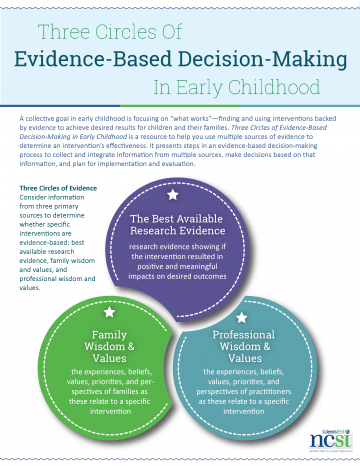Identifying Children's Strengths
Strengths-based assessment practices are used to identify a child's interests and the abilities he or she uses during participation in everyday activities. Multiple sources of information are used to accomplish this important part of an assessment process. Information collected about the things a child likes to do and is able to do provides the foundation for engaging the child in strengths-based everyday learning activities, supporting the child's participation in the activities, and interacting with the child in ways that build on the child's strengths to promote new learning.
Identifying Children’s Abilities and Interests
• Use different methods to gather information about a child’s strengths (i.e., his or her abilities and interests).
• Consider using a child interest and strengths checklist completed by a parent or other adult familiar with the child to identify personal interests and behavioral strengths.
• Use your observations and interviews to identify the child’s abilities.
• Identify how the child initiates and maintains interactions with adults and other people, including peers.
• Identify the activities, events, objects, people, places, and actions that are the child’s interests.
• Record your findings by writing notes, keeping a journal, taking photographs, and collecting samples of the child’s work.
• Use the results of the child strengths assessment to identify and select everyday child learning activities, promoting the child’s participation in the activities, and encouraging and supporting child learning and independence by building on child strengths in the activities.
The Circles of Evidence-Based Decision Making in Early Childhood
A collective goal in early childhood is focusing on “what works”—finding and using interventions backed by evidence to achieve desired results for children and their families. Three Circles of Evidence-Based Decision-Making in Early Childhood is a resource to help you use multiple sources of evidence to determine an intervention’s effectiveness. It presents steps in an evidence-based decision-making process to collect and integrate information from multiple sources, make decisions based on that information, and plan for implementation and evaluation.
Got Evidence - An Animated Video With Some Questions and Answers about Evidence-Based Practices in Early Childhood
This engaging, animated video is part of compilation of products to support ECE professionals to understand the process of using evidence-based decision-making. This video provides quick, easily ‘digestible’ information in plain language for a process that can be intimidating and overwhelming for professionals and stakeholders who are not researchers or evaluators. It focuses on the best available research pertaining to evidence-based practices.

